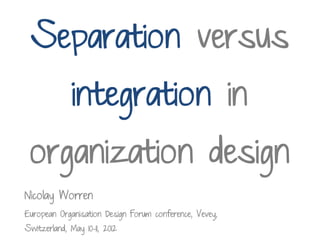My 2012 EODF presentation
- 1. Separation versus integration in organization design Nicolay Worren European Organisation Design Forum conference, Vevey, Switzerland, May 10-11, 2012
- 2. The dilemma Vs. Separation Integration
- 3. Three arguments for separation 1. 2. 3.
- 4. The governance perspective NestlÃĐ Corporate Governance Report Separation of responsibilities
- 6. Universal? âLet the wolf take care of the sheepâ âLet the fox guard the hen houseâ âLet the dingo take care of the kidsâ âLetting the ram take care of the bag of oatsâ. âGiving the keys to the thiefâ
- 7. Three arguments for separation 1. Avoid conflict of interest ïž 2. 3.
- 8. Three arguments for separation 1. Avoid conflict of interest 2. 3.
- 9. Integration leads to coordination... which leads to coordination costs. Time in meetings Corporate e-mail traffic (billions of messages per year) 35 30 25 20 15 1960 10 5 0 2003 2004 2005 2006 1982
- 10. When thereâs no role separation, everybody needs to coordinate with everybody 1 2 3 4 5 6 7 8 9 10 Advisor 1 (responsible for employee survey and x x x x x x x x division 1) 1 Advisor 2 (responsible for performance mngt x x x x x x x and division 2) 2 Advisor 3 (responsible for leadership x x x x x x x development and division 3) 3 Advisor 4 (responsible for competence x x x x x x x x management and division 4) 4 Advisor 5 (responsible for succession planning x x x x x x x and division 5) 5 Advisor 6 (works on performance mngt, x x x x x x x responsible for division 6) 6 Advisor7 (works on leadership development, x x x x x x x responsible for division 7) 7 Advisor 8 (works on employee survey, x x x x x x responsible for division 8) 8 x Advisor 9 (works on employee survey) 9 Advisor 10 (works on competence x management) 10 Source: Worren (2012)
- 11. Three arguments for separation 1. Avoid conflict of interest 2. Minimize coordination cost ïž 3.
- 12. Three arguments for separation 1. Avoid conflict of interest 2. Minimize coordination cost 3.
- 13. Three arguments for separation 1. Avoid conflict of interest 2. Minimize coordination cost 3.
- 14. Pursuing different goals in same vs different unit Q: What's the best way to organize for innovation? Option 1 Option 2 Option 3 Functional structure Cross-functional team Structurally independent Manager Manager Manager Mfg Sales R&D Mfg Sales R&D Existing New New business business business 25% succeeded 90% succeeded Source: OâReilly, C. A. & Tushman, M. L. (2004)
- 15. NestlÃĐ does it âThe corporate team set up a separate unit, fully owned by NestlÃĐ, but completely independent from the main organizationâ Informant in case study of innovation in NestlÃĐ by Raisch & Tushman (2011)
- 16. Three arguments for separation 1. Avoid conflict of interest 2. Minimize coordination cost 3. Avoid goal conflicts ïž
- 17. Resources Blog: Article Book www.organizationdesign.net http://www.amazon.co.uk

















